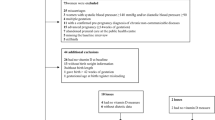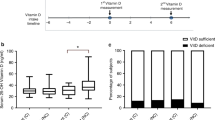Abstract
Background/Objectives:
Preterm infants are at risk for low vitamin D but documentation on late-preterm infants is sparse. This prospective study monitored longitudinally vitamin D and parathormone (PTH) levels in late-preterm formula fed infants during the first year of life, taking into consideration in utero and postnatal growth, and season and diet.
Subjects/Methods:
The study population comprised 128 infants of gestational age (GA) 32–36 weeks, of which 102 were appropriate (AGA) and the remaining 26 were small for GA (SGA). Serum levels of vitamin D (25(OH)D), PTH calcium, phosphate (P) and alkaline phosphate were estimated at 2 and 6 weeks, and at 3, 6, 9 and 12 months of age.
Results:
The 25(OH)D levels were relatively low at 2 and 6 weeks in both AGA and SGA infants (21±11, 20±7 ng/ml and 25±16, 23±8 ng/ml, respectively), but increased at 6 months (45±14, 47±10 ng/ml) and remained stable thereafter. SGA infants had lower 25(OH)D levels at 9 and 12 months (AGA 45±14, 47±18 ng/ml vs SGA 38±13, 37±13 ng/ml, P<0.05). Deficiency of 25(OH)D (<20 ng/ml) was found in 18.5% of measurements in 92 (72%) infants, and its insufficiency (20–32 ng/ml) was found in 29.2% of measurements in 99 (77.3%) infants. Most measurements with vitamin D <32 ng/ml were observed at the first three study points, where PTH showed an inverse association with 25(OH)D, reaching a plateau thereafter.
Conclusions:
Late-preterm, formula fed infants may have suboptimal vitamin D levels and elevated PTH, especially, during the first 3 months. Those born SGA may have lower vitamin D levels up to the end of the first year of life.
This is a preview of subscription content, access via your institution
Access options
Subscribe to this journal
Receive 12 print issues and online access
$259.00 per year
only $21.58 per issue
Buy this article
- Purchase on Springer Link
- Instant access to full article PDF
Prices may be subject to local taxes which are calculated during checkout


Similar content being viewed by others
References
Agostoni C, Buonocore G, Carnielli VP, De Curtis M, Darmaun D, Decsi T et al. (2010). ESPGHAN Committee on Nutrition. Enteral nutrient supply for preterm infants: commentary from the European Society of Paediatric Gastroenterology, Hepatology and Nutrition Committee on Nutrition. J Pediatr Gastroenterol Nutr 50, 85–91.
Ala-Houhala M (1985). 25-hydroxyvitamin D levels during breastfeeding with or without maternal or infantile supplementation of vitamin D. J Pediatr Gastroenterol Nutr 4, 220–226.
Alexander GR, Kogan MD, Himes JH (1999). 1994–1996 U.S. singleton birth weight percentiles for gestational age by race, Hispanic origin, and gender. Matern Child Health J 3, 225–231.
Altman D (1991). Practical Statistics for Medical Research. Chapman and Hall: London, pp 456–460.
Backström MC, Mäki R, Kuusela AL, Sievänen H, Koivisto AM, Ikonen RS et al. (1999). Randomised controlled trial of vitamin D supplementation on bone density and biochemical indices in preterm infants. Arch Dis Child Fetal Neonatal Ed 80, F161–F166.
Bischoff-Ferrari HA, Giovannucci E, Willett WC, Dietrich T, Dawson-Hughes B (2006). Estimation of optimal serum concentrations of 25-hydroxyvitamin D for multiple health outcomes. Am J Clin Nutr 84, 18–28.
Challa A, Ntourntoufi A, Cholevas V, Bitsori M, Galanakis E, Andronikou S (2005). Breastfeeding and vitamin D status in Greece during the first 6 months of life. Eur J Pediatr 164, 724–729.
Chapuy MC, Preziosi P, Maamer M, Arnaud S, Galan P, Hercberg S et al. (1997). Prevalence of vitamin D insufficiency in an adult normal population. Osteoporos Int 7, 439–443.
Delvin EE, Salle BL, Claris O, Putet G, Hascoet JM, Desnoulez L et al. (2005). Oral vitamin A, E and D supplementation of pre-term newborns either breast-fed or formula-fed: a 3-month longitudinal study. J Pediatr Gastroenterol Nutr 40, 43–47.
El-Hajj Fuleihan E, Nabulsi M, Tamim H, Maalouf J, Salamoun M, Khalife H et al. (2006). Effect of vitamin D replacement on musculoskeletal parameters in school children: a randomized controlled trial. J Clin Endocrinol Metab 91, 405–412.
Engle WA, Tomashek KM, Wallman C (2007). Committee on Fetus and Newborn, American Academy of Pediatrics. ‘Late-preterm’ infants: a population at risk. Pediatrics 120, 1390–1401.
Evagelidou E, Giapros VI, Challa AS, Kiortsis DN, Tsatsoulis AA, Andronikou SK (2007). Serum adiponectin levels, insulin resistance, and lipid profile in children born small for gestational age are affected by the severity of growth retardation at birth. Eur J Endocrinol 156, 271–277.
Harkness L, Cromer B (2005). Low levels of 25-hydroxy vitamin D are associated with elevated parathyroid hormone in healthy adolescent females. Osteoporos Int 16, 109–113.
Hathcock JN, Shao A, Vieth R, Heaney RP (2007). Risk assessment for vitamin D. Am J Clin Nutr 85, 6–18.
Heaney RP (2004). Functional indices of vitamin D status and ramifications of vitamin D deficiency. Am J Clin Nutr 80 (suppl), 1706S–1709S.
Henriksen C, Helland IB, Rønnestad A, Grønn M, Iversen PO, Drevon CA (2006). Fat-soluble vitamins in breast-fed preterm and term infants. Eur J Clin Nutr 60, 756–762.
Holick MF (2007). Vitamin D deficiency. N Engl J Med 357, 266–281.
Hypponen E, Laara E, Reunanen A, Jarvelin MR, Virtanen SM (2001). Intake of vitaminD and risk of type 1 diabetes: a birth-cohort study. Lancet 358, 1500–1503.
Kinyamu HK, Gallagher JC, Rafferty KA, Balhorn KE (1998). Dietary calcium and vitamin D intake in elderly women: effect on serum parathyroid hormone and vitamin D metabolites. Am J Clin Nutr 67, 342–348.
Koletzko B, Baker S, Cleghorn G, Neto UF, Gopalan S, Hernell O et al. (2005). Global standard for the composition of infant formula: recommendations of an ESPGHAN coordinated international expert group. J Pediatr Gastroenterol Nutr 41, 584–599.
Koo WW, Krug-Wispe S, Neylan M, Succop P, Oestreich AE, Tsang RC (1995). Effect of three levels of vitamin D intake in preterm infants receiving high mineral-containing milk. J Pediatr Gastroenterol Nutr 21, 182–189.
Krause R, Buhring M, Hopfenmuller W, Holick MF, Sharma AM (1998). Ultraviolet B and blood pressure. Lancet 352, 709–710.
Kumar GT, Sachdev HS, Chellani H, Rehman AM, Singh V, Arora H et al. (2011). Effect of weekly vitamin D supplements on mortality, morbidity, and growth of low birthweight term infants in India up to age 6 months: randomised controlled trial. BMJ 342, d2975. doi: 10.1136/bmj.d2975.
Lappe JM, Travers-Gustafson D, Davies KM, Recker RR, Heaney RP (2007). Vitamin D and calcium supplementation reduces cancer risk: results of a randomized trial. Am J Clin Nutr 85, 1586–1591.
Mericq V, Ong KK, Bazaes R, Peña V, Avila A, Salazar T et al. (2005). Longitudinal changes in insulin sensitivity and secretion from birth to age three years in small- and appropriate-for-gestational-age children. Diabetologia 48, 2609–2614.
Petrini JR, Dias T, McCormick MC, Massolo ML, Green NS, Escobar GJ (2009). Increased risk of adverse neurological development for late preterm infants. J Pediatr 154, 169–176.
Reis JP, von Mühlen D, Kritz-Silverstein D, Wingard DL, Barrett-Connor E (2007). Vitamin D, parathormone levels, and the prevalence of metabolic syndrome in community-dwelling older adults. Diabetes Care 30, 1549–1555.
Roth DE, Martz P, Yeo R, Prosser C, Bell M, Jones AB (2005). Are national vitamin D guidelines sufficient to maintain adequate blood levels in children? Can J Public Health 96, 443–449.
Sichert-Hellert W, Wenz G, Kersting M (2006). Vitamin intakes from supplements and fortified food in German children and adolescents: results from the DONALD study. J Nutr 136, 1329–1333.
Specker BL, Valanis B, Hertzberg V, Edwards N, Tsang RC (1985). Sunshine exposure and serum 25-hydroxyvitamin D concentrations in exclusively breast-fed infants. J Pediatr 107, 372–376.
Vieth R, Bischoff-Ferrari H, Boucher BJ, Dawson-Hughes B, Garland CF, Heaney RP et al. (2007). The urgent need to recommend an intake of vitamin D that is effective. Am J Clin Nutr 85, 649–650.
Viljakainen HT, Natri AM, Karkkainen MM, Huttunen MM, Palssa A, Jakobsen J et al. (2006). J Bone Miner Res 21, 836–844.
Wagner CL, Greer FR (2008). Section on Breastfeeding and Committee on Nutrition, American Academy of Pediatrics. Prevention of rickets and vitamin D deficiency in infants, children, and adolescents. Pediatrics 122, 1142–1152.
Weng FL, Shults J, Leonard MB, Stallings VA, Zemel BS (2007). Risk factors for low serum 25-hydroxyvitamin D concentrations in otherwise healthy children and adolescents. Am J Clin Nutr 86, 150–158.
Wilkins CH, Sheline YI, Roe CM, Birge SJ, Morris JC (2006). Vitamin D deficiency is associated with low mood and worse cognitive performance in older adults. Am J Geriatr Psychiatry 14, 1032–1040.
Willis CM, Laing EM, Hall DB, Hausman DB, Lewis RD (2007). A prospective analysis of plasma 25-hydroxyvitamin D concentrations in white and black prepubertal females in the southeastern United States. Am J Clin Nutr 85, 124–130.
Ziegler EE, Hollis BW, Nelson SE, Jeter JM (2006). Vitamin D deficiency in breastfed infants in Iowa. Pediatrics 118, 603–610.
Author information
Authors and Affiliations
Corresponding author
Ethics declarations
Competing interests
The authors declare no conflict of interest.
Rights and permissions
About this article
Cite this article
Giapros, V., Schiza, V., Challa, A. et al. Vitamin D and parathormone levels of late-preterm formula fed infants during the first year of life. Eur J Clin Nutr 66, 224–230 (2012). https://doi.org/10.1038/ejcn.2011.158
Received:
Revised:
Accepted:
Published:
Issue Date:
DOI: https://doi.org/10.1038/ejcn.2011.158
Keywords
This article is cited by
-
Functional indicators of vitamin D adequacy for very low birth weight infants
Journal of Perinatology (2018)
-
A randomized double-blind controlled trial comparing two regimens of vitamin D supplementation in preterm neonates
Journal of Perinatology (2016)
-
Vitamin D in childhood and adolescence: an expert position statement
European Journal of Pediatrics (2015)
-
Multidisciplinary guidelines for the care of late preterm infants
Journal of Perinatology (2013)



